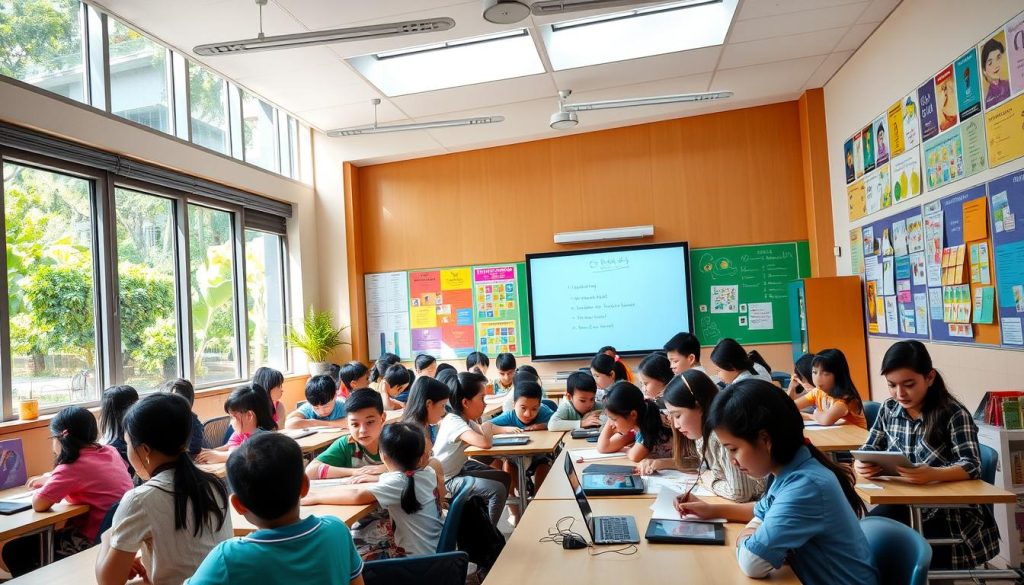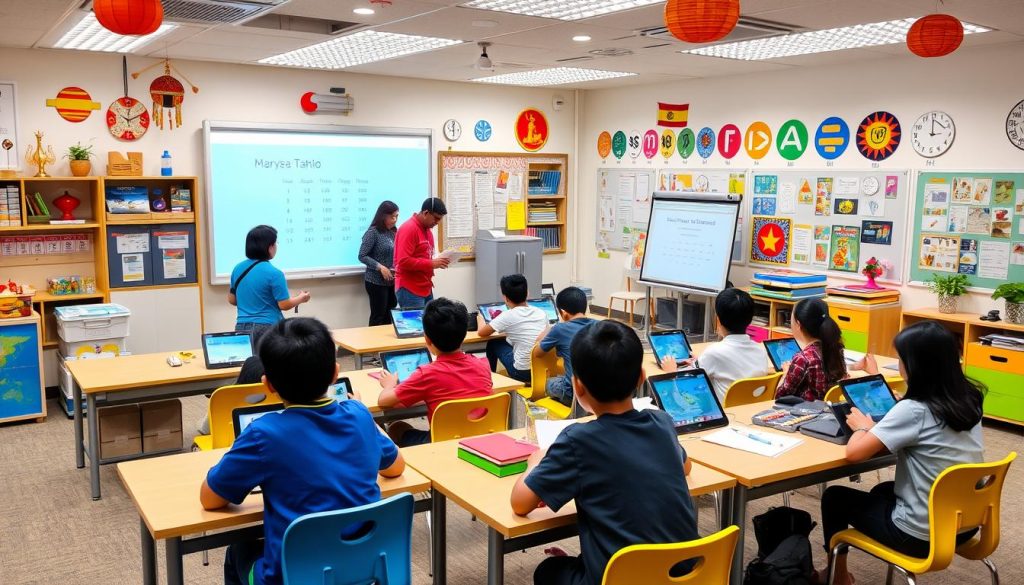The Asian continent is seeing big changes in its education scene. This is thanks to a growing economy and more investment in education. As people want better learning experiences, new educational business opportunities in Asia are popping up.
These chances are great for entrepreneurs and investors. The growing middle class and better access to technology show the potential of educational markets here. It’s clear that we need innovative solutions to meet different learning needs.
The Growing Demand for Education in Asia

The need for education in Asia is growing fast. This is because of many reasons. Countries like India and China are seeing their populations grow quickly. This means there are more young people looking for better education to help them succeed.
This growth puts a lot of pressure on schools and universities. They need to improve how they teach and make education more accessible.
Factors Driving Demand
Several things are making people want better education:
- Urbanisation: More people are moving to cities. This means there’s a bigger need for skilled workers, leading to more demand for schools and universities.
- Social Mobility Aspirations: Families see education as a way to get ahead. So, more kids are going to school to improve their family’s status.
- Knowledge-Based Economies: The world is moving towards economies that rely on knowledge and technology. This means people need to be better educated to keep up.
- Government Support: Governments are starting new programs and making changes to help education. They see how important it is for the economy to grow.
As these factors continue, it’s crucial to focus on quality education. This is to meet the needs of the growing number of young people and support the economy in the future.
Key Markets for Educational Businesses

Asia is home to a wide range of educational markets. Countries like China, India, Vietnam, and Indonesia are key players. Each has its own culture, educational needs, and government plans to improve schools.
Emerging Market Trends
Market research shows important trends in these Asian educational markets. Here are some key points:
- China is investing a lot in private education, meeting parents’ high standards.
- India has seen a big rise in online learning, helping both city and country learners.
- Vietnam is focusing on teaching English, creating a big demand for related products and services.
- Indonesia is pushing for vocational training, linking education to its economic goals.
Knowing these trends helps find good places to invest. By understanding what people want, businesses can improve their position in Asia’s education market.
Innovative EdTech Solutions

The education world is changing fast, especially in Asia. New digital tools are making classrooms better and learning more fun. These tools are making education reach more people and be more engaging.
Technology Integration in Education
Technology in schools is getting smarter. Schools are using AI and machine learning to make learning fit each student’s needs. Companies like Byju’s and VIPKid are leading this change with their platforms.
These platforms offer learning that’s tailored to each student. They adjust to how each learner learns best, making learning more fun and effective.
Online and in-person learning are coming together. This mix makes learning richer and gets students more involved. As schools see the value of digital tools, they’ll use them more, making learning even better.
Educational Franchising in Asia

Educational franchising is a big chance for those wanting to get into the fast-growing Asian markets. It offers a way to grow a business without starting from the beginning. This is because it uses an already known brand and a tested way of working.
Benefits of Franchising Models
Franchising in education has many good points:
- It lets businesses quickly get into the market, which is always in demand.
- It’s less risky because it uses a well-known brand and a proven way of doing things.
- Franchisees get help with training and how to run the business, which helps them succeed.
- Businesses can change their services to fit what the local market needs, keeping customers interested.
Successful examples of educational franchises include language schools and tutoring centres. They meet the educational needs of the area. These franchises not only offer good business chances but also help improve education in the community.
Collaborative Learning Platforms

Collaborative learning platforms are transforming education. They create a space where students can work together. This approach boosts the idea of learning together, forming online communities.
Students share knowledge and resources through peer learning. This helps everyone grow and learn more.
Empowering Student Engagement
Online study groups and educational forums are becoming popular. They let students collaborate on projects and support each other. This builds a sense of community and improves learning outcomes.
These platforms make students more motivated and engaged. They are key to modern education.
Educational Business Opportunities in Asia

The educational scene in Asia is full of chances for investment. It covers everything from early learning to university levels. Entrepreneurs can find many ways to offer new educational products. These products meet the special needs of learners across different areas.
The need for custom services like learning materials, digital tests, and extra activities is growing. This shows the sector’s potential for growth.
To succeed, a deep market analysis is needed. It helps understand local needs, cultural values, and education standards. This is crucial in the competitive world of education.
Some great business ideas include:
- Online course platforms that offer flexible learning.
- Consulting services for improving educational programs.
- Creating engaging educational products like e-books and apps.
- After-school programs to boost students’ skills.
Entrepreneurs should look for specific markets within these areas. This helps them attract more learners. Knowing what students and schools want is essential for success in this field.
The Role of Government Policies in Education

Government education policies are key in shaping education in Asia. They create frameworks that encourage investment and reform. Many Asian governments aim to boost education by supporting investment in the sector.
These policies are crucial for promoting growth in educational businesses. They help in recognizing the importance of a well-educated population.
Supporting Educational Initiatives
Setting national standards for primary and secondary education is a top priority. This aims to improve education quality and ensure uniformity across regions. Governments also encourage the private sector to get involved in education.
This opens up opportunities for innovative companies, especially in EdTech.
- Funding for educational projects has increased, showing a commitment to better school infrastructure.
- There are tax incentives for educational businesses to encourage growth.
- Teacher training gets a lot of support, helping to have skilled educators in classrooms.
It’s important for businesses to understand these government policies. Aligning strategies with these initiatives can benefit everyone in the education sector.
Cultural Factors Influencing Education

Culture plays a big role in how education works in Asia. Different local values shape learning in many ways. This affects things like what parents expect, how teachers teach, and how students get involved.
Knowing about these cultural aspects helps education providers make things that fit the needs of different groups.
Impact of Cultural Norms
In Asia, cultural norms shape education in unique ways. Some places focus on remembering facts, while others value thinking creatively. This means education services need to respect local traditions but also bring new ideas.
- Parental expectations often reflect cultural values, influencing student performance.
- Teaching methods may vary between formal instruction and collaborative learning, depending on region.
- Learning preferences can shift due to cultural beliefs surrounding education and its purposes.
So, understanding cultural influences in education is crucial for success in Asia’s changing education scene.
Investment in Teacher Training Programs

Improving education in Asia depends a lot on teacher training. As education changes fast, teachers need to keep learning. Good teachers help students do well and stay interested.
Both governments and private groups are putting more money into training teachers. They want to give teachers the skills they need.
Importance of Qualified Educators
Good teachers are key to high-quality education. They learn new ways to teach and use technology. This helps them keep up with education’s changes.
Training teachers opens up new chances for businesses. It lets them create and sell educational content and training.
- Enhancement of teaching methodologies through targeted training
- Increased effectiveness in student engagement strategies
- Development of innovative approaches to classroom technology
More money for teacher training means better education. It shows how important it is to support teachers well. This support helps teachers do their best and helps students succeed.
Opportunities in Vocational Training

The job market in Asia is changing fast. This has made vocational training very important. It helps fill skill gaps in areas like healthcare, manufacturing, and tech.
As economies expand, finding the right workers becomes a big challenge. Vocational training is key to solving this problem.
Addressing Skill Shortages
Government and schools are working hard to offer more vocational courses. These courses are designed to meet the needs of the job market. This helps businesses in many ways.
- They can create special courses that fit local industry needs.
- They can offer apprenticeships for practical training.
- They can set up training centres with the latest technology.
By matching training with job market needs, companies can lower unemployment. They can also make their workforce better. This boosts productivity and helps the economy grow.
Partnerships with Local Educational Institutions

Working with local schools is key to success in Asia’s education world. These partnerships make learning more relevant and encourage new ideas. They help create programs that meet both local needs and global standards.
Strengthening Educational Networks
When schools work together, they achieve great things. They create new courses and exchange programs. These efforts lead to:
- Sharing knowledge among teachers and students
- Access to better learning materials
- Research projects that grow knowledge
Building strong ties with local schools can be tough. It involves dealing with cultural differences and different rules. But, knowing the local scene helps make partnerships work better. This leads to better education in the area.
Utilising Artificial Intelligence in Education

Artificial intelligence (AI) is changing education by making learning more personal. Schools are using AI tools to improve teaching. These tools help adapt lessons to each student’s needs.
They also make grading easier for teachers. This lets teachers spend more time teaching and engaging with students.
Enhancing Learning Experiences
AI projects in Asia show big improvements in education. These projects use analytics to understand how students learn. This helps teachers help students better.
The main benefits of AI in education are:
- Learning experiences that fit each student’s style and ability.
- Teachers have more time for students because of automation.
- Teachers can improve their teaching based on data.
But, we must think about the ethics of using AI in schools. It’s important to use AI responsibly. This ensures a fair learning environment for everyone.
As technology gets better, leaders must be careful. They should aim to make learning fair and open to all.
The Impact of Mobile Learning

Mobile learning is changing education, especially in Asia. More people use smartphones to learn. This makes education more accessible to everyone.
Accessibility and Flexibility
Mobile learning offers many benefits. It’s more flexible than traditional classrooms. Key advantages include:
- Real-time feedback, allowing students to gauge their progress instantly.
- Interactive lessons that keep learners engaged and motivated.
- The ability to study from anywhere, whether at home or on the go.
New mobile learning platforms are designed for Asia. They offer offline content and personalised learning. This shows how mobile tech can improve education.
Expansion of Online Learning Platforms

Online learning platforms are growing fast, changing education a lot. The COVID-19 pandemic sped up this change, making digital classrooms more common. Now, many e-learning sites offer courses for different learners and needs.
Big names like Coursera and edX are known for their wide range of courses. Local sites also offer courses in regional languages and cultures. This shows a move towards learning that fits each person’s background and interests.
Shaping the Future of Education
Traditional schools face big changes with online education. They must compete with big names and new start-ups. Online learning will likely change how we teach, making it more interactive and easy to access.
- Increased student engagement through gamified learning experiences.
- Flexibility in course selection, enabling tailored learning paths.
- Opportunities for collaboration across diverse geographical locations.
- Access to high-quality educational resources regardless of physical location.
Online learning keeps getting better, making education more accessible. It also questions old ideas about classroom learning. As schools adjust, education will mix digital and traditional ways, becoming more open and flexible.
Market Trends Influencing Educational Choices

In recent years, education has changed a lot. Now, people focus more on lifelong learning and skills training. Micro-credentials are also becoming popular. These changes show a move away from just getting degrees to more flexible learning paths.
Adapting to Learner Preferences
It’s key for schools to understand what learners want. They need to be flexible to meet these changing needs. Here are some important changes:
- Adding practical skills to courses to help students get jobs.
- Letting students learn at their own speed with personal plans.
- Offering different ways to learn, like online and mix-and-match options.
- Creating short, easy-to-digest learning bits for busy people.
These trends mean educational leaders must think differently. They need to use new methods to keep up with the times. This way, they can meet the needs of today’s learners.
Challenges in Entering the Asian Education Market

The Asian education market is full of chances, but there are also big hurdles. New players face tough rules, strong competition, cultural gaps, and different learning standards. It’s key to know these obstacles to succeed in the area. This part looks at these challenges and shares tips on how to get into the market smoothly.
Navigating Market Entry Barriers
Companies new to the Asian education market should think about a few main points:
- Rules can change a lot from country to country, so you need to know the local laws well.
- Different cultures mean different tastes and learning ways, so you must adjust your offerings.
- Big players already have a strong hold, so you need to stand out in some way.
- Learning quality can vary, so you must keep your standards high to be trusted.
To beat these hurdles, good strategies include:
- Doing deep research to find out what locals want and like.
- Talking to local people to build connections and get valuable info.
- Working with well-known schools to boost your reputation and trust.
Future Prospects for Educational Investments in Asia
The educational scene in Asia is full of chances for investors. With a strong economic outlook, the area is seeing big changes. These include new demographics and tech advancements, leading to fresh educational ideas.
Investors who spot these trends can find great spots in a market that’s always growing. This market is changing fast, offering many chances for growth.
Long-term Growth Opportunities
As more people want better education, areas like EdTech and vocational training are set to do well. The focus will be on creating educational experiences that fit different needs. This will meet the high expectations of students and parents.
This shift will also boost the growth of the educational sector in Asia. It’s a win-win for everyone involved.
There’s also a chance for more collaboration among schools, support from governments, and more foreign investment. These factors make Asia a great place for long-term investment in education. Those in the education world can use these chances to grow and stay ahead in Asia’s changing education scene.
















